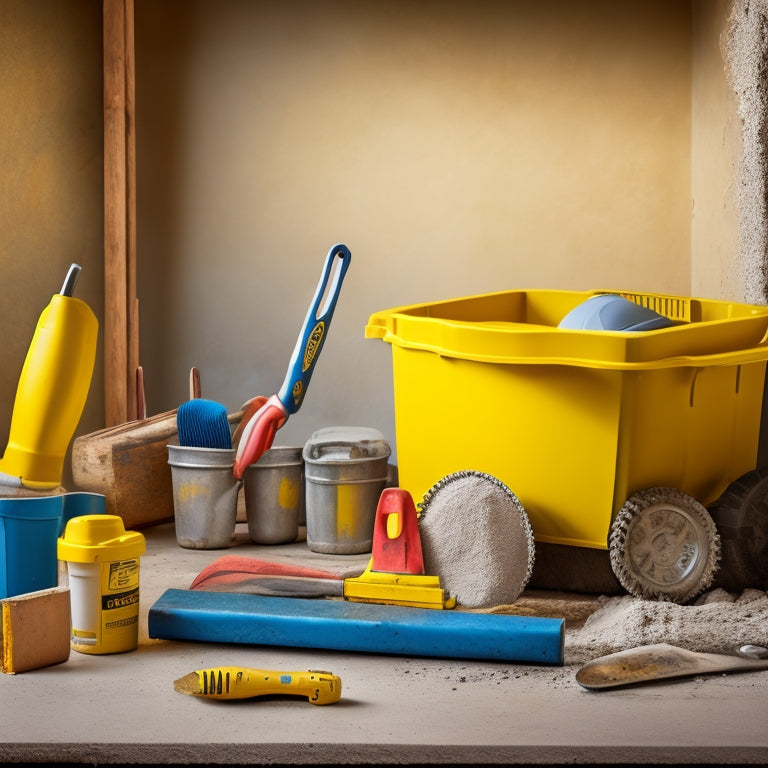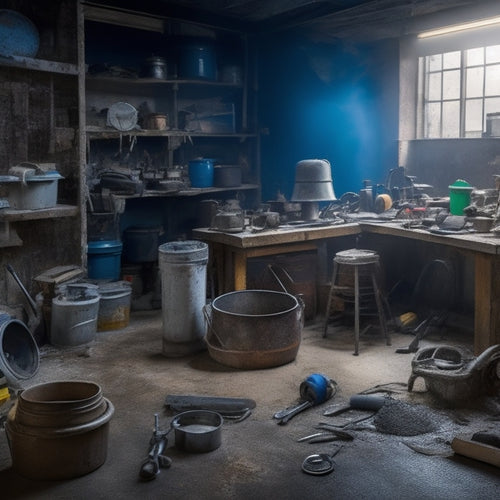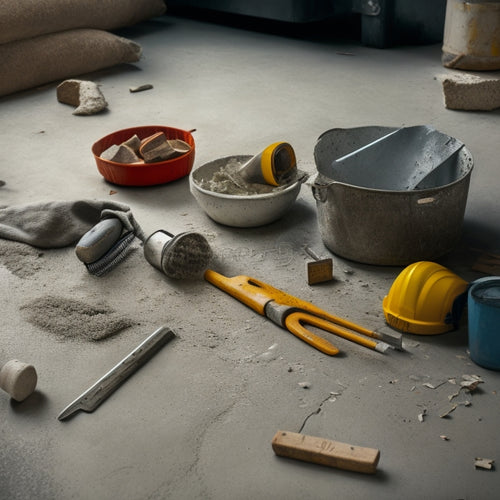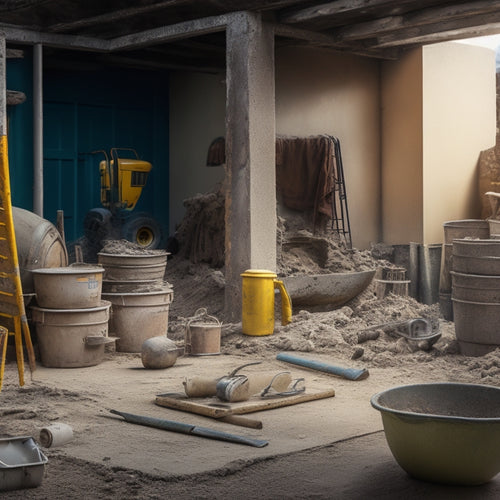
3 Best Power Tools for Concrete Plastering Success
Share
To achieve concrete plastering success, you'll need the right power tools. A drill mixer is essential for efficiently mixing large quantities of plaster. A reciprocating saw is perfect for cutting through concrete and metal materials, while an angle grinder is ideal for grinding and polishing surfaces for a smooth finish. Regular maintenance of these tools is vital to extend their lifespan and guarantee safety and efficiency. By choosing the correct power tools and understanding their applications, you'll be well on your way to achieving a professional-grade concrete plaster finish - but there are more key tools and techniques to take into account for best results.
Key Takeaways
- A Drill Mixer is ideal for efficiently mixing large quantities of concrete plaster.
- A Reciprocating Saw is perfect for cutting through concrete and metal materials.
- An Angle Grinder is excellent for grinding and polishing surfaces for a smooth finish.
- Regular maintenance of power tools is crucial for extending lifespan and enhancing safety and efficiency.
- A Drill with Mixing Paddle is essential for large-scale plaster mixing tasks for concrete plastering success.
Top Power Tools for Plastering
When tackling concrete plastering projects, selecting the right power tools is vital. You'll want to reflect on investing in a high-quality drill mixer, a versatile reciprocating saw, and a reliable angle grinder. These tools will enable you to execute plastering techniques efficiently, guaranteeing a smooth and even finish.
A drill mixer is perfect for mixing large quantities of plaster, while a reciprocating saw is ideal for cutting through concrete and metal. An angle grinder is great for grinding and polishing surfaces.
To get the most out of your power tools, regular maintenance is essential. You'll want to check your tools before each use, confirming they're in good working condition. This includes inspecting for damage, cleaning, and lubricating moving parts.
Proper tool maintenance won't only extend the lifespan of your tools but also prevent accidents and provide peak performance. By investing in the right power tools and maintaining them properly, you'll be able to tackle concrete plastering projects with confidence and achieve professional-looking results.
With the right tools and techniques, you'll be free to focus on creating high-quality finishes that meet your standards.
Essential Tools for Smooth Finishing
With your power tools in good working condition, you can now focus on the specialized tools that will help you achieve a smooth finish, starting with a high-quality trowel and a set of precision floats. These tools are essential for surface preparation and finishing techniques. A trowel helps to spread and smooth out the plaster, while precision floats are used to remove excess material and create a uniform surface.
| Tool | Description |
|---|---|
| Trowel | Used for spreading and smoothing out plaster |
| Precision Floats | Removes excess material and creates a uniform surface |
| Edging Trowel | Used for creating clean edges and corners |
| Finishing Knife | Removes excess plaster and creates a smooth finish |
When selecting a trowel, consider the type of plaster you're working with and the size of the area you need to cover. Precision floats come in different sizes and shapes, so choose the one that best fits your needs. Edging trowels and finishing knives are also essential for creating a professional-looking finish. By using these tools, you'll be able to achieve a smooth, even surface that's perfect for painting or applying a finish coat.
Must-Have Tools for Concrete Plaster
To guarantee a strong bond between the concrete and plaster, you'll need to have the right tools on hand, starting with a concrete bonding agent and a plaster mixer. The bonding agent ensures a secure connection between the two materials, while the plaster mixer allows for efficient and thorough plaster mixing. A drill with a mixing paddle attachment is also essential for large-scale plaster mixing projects.
In addition to these tools, you'll need to focus on surface preparation to guarantee a smooth and even finish. A wire brush or a scrub brush can be used to remove any debris or imperfections from the concrete surface. A vacuum cleaner or a blower can also be used to remove dust and other particles. A level and a straightedge can be used to ensure the surface is even and plumb.
Frequently Asked Questions
What Is the Ideal Work Environment for Plastering?
To work effectively, you're aiming for an environment that supports precise results.
Ideal conditions start with temperature - a stable 64-72°F (18-22°C) lets materials respond as expected.
Next, humidity levels become essential - keep it between 40-60%. At this sweet spot, moisture helps with spread and flow while avoiding common defects like bubbling and marring.
Master this blend for each unique mixture. This subtle balancing act contributes heavily to outcomes with incredible predictability, critical to expanding the capacity and allowing unparalleled crafting within personal autonomy.
This process propels progression unrestricted in sculpted layers, yielding structural masterpiece evolution!
Can I Use a Drill for Mixing Plaster?
You're about to jump into a plastering project, and the clock is ticking like a time bomb, ready to release a mess if you don't mix it right.
Can you use a drill for mixing plaster? Yes, but choose the right drill type - a heavy-duty, variable-speed drill with a mixing paddle attachment is ideal.
Master mixing techniques like the 'fold and scrape' method to avoid lumps and air pockets, ensuring a smooth finish that sets you free from repair headaches.
How Often Should I Clean My Plastering Tools?
You should clean your plastering tools regularly to maintain their effectiveness and extend their lifespan. A good rule of thumb is to clean them after every use, especially if you're working with a variety of materials.
Daily cleaning prevents plaster buildup and guarantees smooth operation. Set aside time at the end of each workday to scrub and rinse your tools.
Regular tool maintenance also helps prevent damage and reduces the need for costly repairs.
What Safety Gear Is Essential for Plastering?
You might think safety gear is restrictive, but it's actually liberating. When you're protected, you can focus on your craft.
For plastering, essential safety gear includes a dust mask, safety glasses, and gloves. Don't settle for subpar equipment – invest in gear that meets safety standards.
A good respirator will filter out airborne particles, while impact-resistant glasses will safeguard your eyes.
Prioritize your well-being and choose protective equipment that sets you free to create.
Can I Use a Power Tool for Small Plastering Projects?
You can definitely use a power tool for small plastering projects, depending on the specific task.
For smoothing and finishing, a power trowel or a plastering mixer is ideal.
For cutting and shaping, a rotary hammer or a reciprocating saw can be used.
When choosing a power tool, consider the plastering techniques you'll be using and the type of power tool that best suits the job.
Don't forget to follow safety guidelines to guarantee a successful project.
Conclusion
You've got the right tools for concrete plastering success. With the top power tools, essential tools for smooth finishing, and must-have tools for concrete plaster, you're all set.
Did you know that the global plaster market is projected to reach $93.4 billion by 2025, growing at a CAGR of 5.5%? This growth highlights the increasing demand for efficient and high-quality plastering solutions.
By investing in the right power tools, you'll be well-equipped to capitalize on this trend and deliver exceptional results.
Related Posts
-

7 Tools to Fix Damaged Concrete Floors
You're about to tackle that damaged concrete floor, and the right tools are essential for a successful repair. Start ...
-

Top 10 Concrete Repair Tools for Small Fixes
You'll need the right tools to tackle small concrete repairs efficiently and effectively. When it comes to small fixe...
-

What Tools Are Needed for Concrete Wall Foundations
You'll need a thorough array of tools and equipment to construct a concrete wall foundation that meets structural int...


